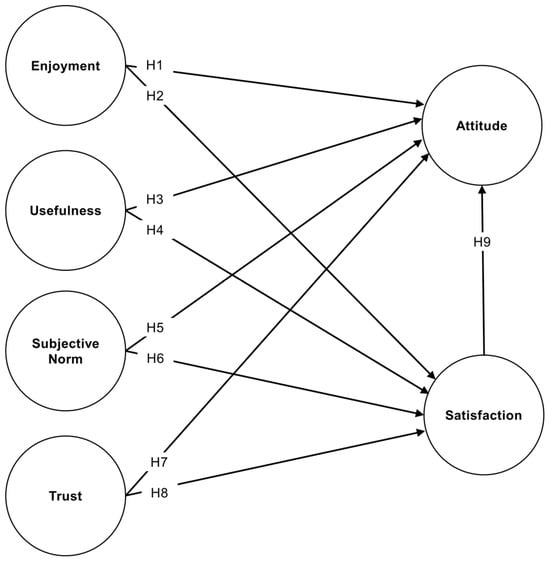Journal Description
Journal of Theoretical and Applied Electronic Commerce Research
Journal of Theoretical and Applied Electronic Commerce Research
published since 2006, is an international, peer-reviewed, scientific journal owned by the Faculty of Engineering of the Universidad de Talca, and MDPI provides publishing services for the journal since Volume 16, Issue 3 (2021).
- Open Access— free for readers, with article processing charges (APC) paid by authors or their institutions.
- High Visibility: indexed within Scopus, SSCI (Web of Science), dblp, and other databases.
- Journal Rank: JCR - Q2 (Business) / CiteScore - Q1 (General Business, Management and Accounting)
- Rapid Publication: manuscripts are peer-reviewed and a first decision is provided to authors approximately 38.4 days after submission; acceptance to publication is undertaken in 4.9 days (median values for papers published in this journal in the second half of 2023).
- Recognition of Reviewers: APC discount vouchers, optional signed peer review, and reviewer names published annually in the journal.
Impact Factor:
5.6 (2022);
5-Year Impact Factor:
5.4 (2022)
Latest Articles
Does Experience Matter? Unraveling the Drivers of Expert and Non-Expert Mobile Consumers
J. Theor. Appl. Electron. Commer. Res. 2024, 19(2), 958-974; https://doi.org/10.3390/jtaer19020050 - 22 Apr 2024
Abstract
The surge in mobile shopping faces a challenge as not all potential consumers are comfortable with this mode. Retailers need a deeper understanding of factors influencing user experience to enhance marketing strategies. Despite extensive research, a gap remains in comprehending this aspect. Using
[...] Read more.
The surge in mobile shopping faces a challenge as not all potential consumers are comfortable with this mode. Retailers need a deeper understanding of factors influencing user experience to enhance marketing strategies. Despite extensive research, a gap remains in comprehending this aspect. Using a statistical PLS-SEM-ANN approach, this research aims to explore the psychological dimensions of expert and non-expert mobile shoppers for establishing better targeted marketing strategies in m-commerce settings. Analyzing experience levels in mobile commerce (m-commerce), key drivers like enjoyment, usefulness, subjective norms, and trust were scrutinized as interaction settings for consumers using mobile technologies. The findings reveal that, for less experienced m-shoppers, trust is the most significant driver of attitude and satisfaction, while, for experienced users, trust and usefulness are the primary antecedents. This research provides novel insights, aiding mobile marketers in refining targeting strategies based on consumer experience levels, emphasizing the importance of usefulness and trustworthiness for a seamless m-shopping experience.
Full article
(This article belongs to the Collection Enhancing Consumer Experience through Mobile Commerce: Challenges and Opportunities)
►
Show Figures
Open AccessArticle
Tailoring Garment Fit for Personalized Body Image Enhancement: Insights from Digital Fitting Research
by
Jiayin Li, Xing Su, Jiahao Liang, P. Y. Mok and Jintu Fan
J. Theor. Appl. Electron. Commer. Res. 2024, 19(2), 942-957; https://doi.org/10.3390/jtaer19020049 - 22 Apr 2024
Abstract
In the context of the Fashion Apparel Industry 4.0, a transformative evolution is directed towards the Online Apparel Mass Customization (OAMC) strategy, which provides efficient and personalized apparel product solutions to consumers. A critical challenge within this customization process is the determination of
[...] Read more.
In the context of the Fashion Apparel Industry 4.0, a transformative evolution is directed towards the Online Apparel Mass Customization (OAMC) strategy, which provides efficient and personalized apparel product solutions to consumers. A critical challenge within this customization process is the determination of sizes. While existing research addresses comfort evaluation in relation to wearer and garment fit, little attention has been given to how garment fit influences the wearer’s body image, which is also an important purchase consideration. This study investigates the impact of garment fit on the wearer’s body scale perception using quantitative research design. A digital dataset of avatars, clothed in varying sizes of T-shirts, were created for the body scale perception experiment, and an Artificial Neural Network (ANN) model was developed to predict the effect of T-shirt fit on body image. With only a small number of garments and body measurements as inputs, the ANN model can accurately predict the body scales of the clothed persons. It was found that the effect of apparel fit on body image varies depending on the wearer’s gender, body size, and shape. This model can be applied to enhance the online garment shopping experience with respect to personalized body image enhancement.
Full article
(This article belongs to the Collection Exploring the Future of Creative Economy: Transforming Creative Industries through Innovation, Technology and Enhanced Consumer Engagement)
►▼
Show Figures
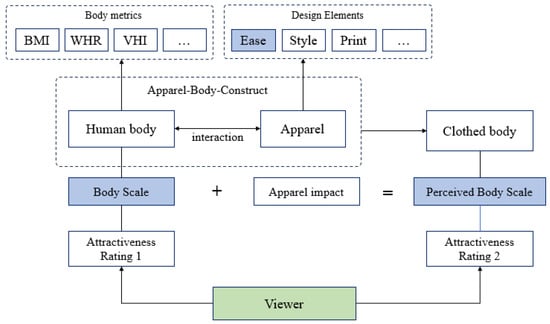
Figure 1
Open AccessArticle
Whether to Add a Digital Product into Subscription Service?
by
Linlan Zhang and Yu Zhang
J. Theor. Appl. Electron. Commer. Res. 2024, 19(2), 921-941; https://doi.org/10.3390/jtaer19020048 - 20 Apr 2024
Abstract
Digital products companies are increasingly adopting subscription pricing, but consumers who pay the subscription service may not be able to access all digital products sold on the sales platform. This paper explores the question of why some digital products are not in the
[...] Read more.
Digital products companies are increasingly adopting subscription pricing, but consumers who pay the subscription service may not be able to access all digital products sold on the sales platform. This paper explores the question of why some digital products are not in the subscription service of the sales platform. To address this problem, we develop an analytical model to examine two strategies of the firm. One is that the firm does not add the new product into the subscription service, the other is that the firm adds the new product into the subscription service. By comparing the profits under two sets, we find the condition under which the firm should add the new digital product into the subscription service. The results show that if the percentage of existing subscribers is below a certain threshold, and the subscription price is over a certain threshold, it is better for the firm to add the new product into the subscription service. We also analyze how the main variables affect the firm’s profit and the piracy rate. Our research provides useful insights for firms in choosing pricing schemes for the newly released product and offers advice for policymakers on controlling the piracy rate of digital products industry.
Full article
(This article belongs to the Section Digital Marketing and the Connected Consumer)
►▼
Show Figures

Figure 1
Open AccessArticle
Role of Algorithm Awareness in Privacy Decision-Making Process: A Dual Calculus Lens
by
Sujun Tian, Bin Zhang and Hongyang He
J. Theor. Appl. Electron. Commer. Res. 2024, 19(2), 899-920; https://doi.org/10.3390/jtaer19020047 - 20 Apr 2024
Abstract
In the context of AI, as algorithms rapidly penetrate e-commerce platforms, it is timely to investigate the role of algorithm awareness (AA) in privacy decisions because it can shape consumers’ information-disclosure behaviors. Focusing on the role of AA in the privacy decision-making process,
[...] Read more.
In the context of AI, as algorithms rapidly penetrate e-commerce platforms, it is timely to investigate the role of algorithm awareness (AA) in privacy decisions because it can shape consumers’ information-disclosure behaviors. Focusing on the role of AA in the privacy decision-making process, this study investigated consumers’ personal information disclosures when using an e-commerce platform with personalized algorithms. By integrating the dual calculus model and the theory of planned behavior (TPB), we constructed a privacy decision-making model for consumers. Sample data from 581 online-shopping consumers were collected by a questionnaire survey, and SmartPLS 4.0 software was used to conduct a structural equation path analysis and a mediating effects test on the sample data. The findings suggest that AA is a potential antecedent to the privacy decision-making process through which consumers seek to evaluate privacy risks and make self-disclosure decisions. The privacy decision process goes through two interrelated trade-offs—that threat appraisals and coping appraisals weigh each other to determine the (net) perceived risk and, then, the (net) perceived risk and the perceived benefit weigh each other to decide privacy attitudes. By applying the TPB to the model, the findings further show that privacy attitudes and subjective norms jointly affect information-disclosure intention whereas perceived behavioral control has no significant impact on information-disclosure intention. The results of this study give actionable insights into how to utilize the privacy decision-making process to promote algorithm adoption and decisions regarding information disclosure, serving as a point of reference for the development of a human-centered algorithm based on AA in reference to FEAT.
Full article
(This article belongs to the Topic Online User Behavior in the Context of Big Data)
►▼
Show Figures

Figure 1
Open AccessArticle
eWOM Information Richness and Online User Review Behavior: Evidence from TripAdvisor
by
Xueyu Liu, Jie Lin, Xiaoyan Jiang, Tingzhen Chang and Haowen Lin
J. Theor. Appl. Electron. Commer. Res. 2024, 19(2), 880-898; https://doi.org/10.3390/jtaer19020046 - 18 Apr 2024
Abstract
The growing number of online users commenting on review platforms has fueled the development of electronic word–of–mouth (eWOM). At the same time, merchants have improved their requirements for the length and frequency of online reviews. However, few studies have examined the updating mechanism
[...] Read more.
The growing number of online users commenting on review platforms has fueled the development of electronic word–of–mouth (eWOM). At the same time, merchants have improved their requirements for the length and frequency of online reviews. However, few studies have examined the updating mechanism of online reviews length and frequency from the perspective of businesses. This study explores the relationship between online commenting platform users and eWOM and examines how eWOM information richness affects online user review behavior. We used media richness theory (MRT) to quantify the information richness of eWOM content (linguistic, textual, and photographical) to build an empirical framework. For the research data, we used advanced big data analytics to retrieve and analyze TripAdvisor data on restaurant services in nine major tourist destinations, the United States, Mexico, and mainland Europe (including UK, Spain, Netherlands, etc.), over a long period of time. Based on >10 million eWOM, this study used multiple regression to examine the impact of eWOM information richness on online user review behavior, considering the moderating effect of information ambiguity. Our research results show that content information richness positively affects online user review behavior, increasing their frequency and length. Information ambiguity play a moderating role that strengthens this relationship. This supports our theoretical hypothesis. Finally, for greater applicability and reliability, we conducted a comparative study on the degree of differences in the relationship between eWOM and users based on different cultural backgrounds across countries.
Full article
(This article belongs to the Topic Online User Behavior in the Context of Big Data)
►▼
Show Figures
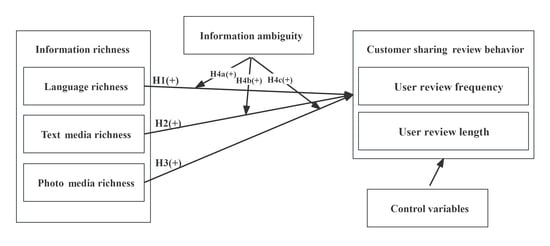
Figure 1
Open AccessArticle
Understanding the Adoption Dynamics of ChatGPT among Generation Z: Insights from a Modified UTAUT2 Model
by
Antun Biloš and Bruno Budimir
J. Theor. Appl. Electron. Commer. Res. 2024, 19(2), 863-879; https://doi.org/10.3390/jtaer19020045 - 13 Apr 2024
Abstract
This research delves into the factors influencing the adoption of ChatGPT, a sophisticated AI-based chatbot, among Generation Z members in Croatia. Employing an extended UTAUT2 model, the impact of various factors on the behavioral intention to use ChatGPT is explored. The study included
[...] Read more.
This research delves into the factors influencing the adoption of ChatGPT, a sophisticated AI-based chatbot, among Generation Z members in Croatia. Employing an extended UTAUT2 model, the impact of various factors on the behavioral intention to use ChatGPT is explored. The study included 694 Generation Z participants, and data were collected through an online survey featuring self-reporting questions. The analysis utilized statistical software packages for performing both confirmatory and exploratory factor analyses, in addition to hierarchical linear regression. Key findings reveal that performance expectancy, social influence, hedonic motivation, habit, and personal innovativeness significantly influence the behavioral intention to use ChatGPT. However, effort expectancy, facilitating conditions, and price value do not exhibit a significant impact. Notably, the study excludes the use behavior factor due to multicollinearity issues with behavioral intention. While the research does not focus on moderating factors, it reports that the adapted UTAUT2 model explains 65% of the variance in the adoption of ChatGPT by Generation Z users.
Full article
(This article belongs to the Section Digital Marketing and the Connected Consumer)
►▼
Show Figures
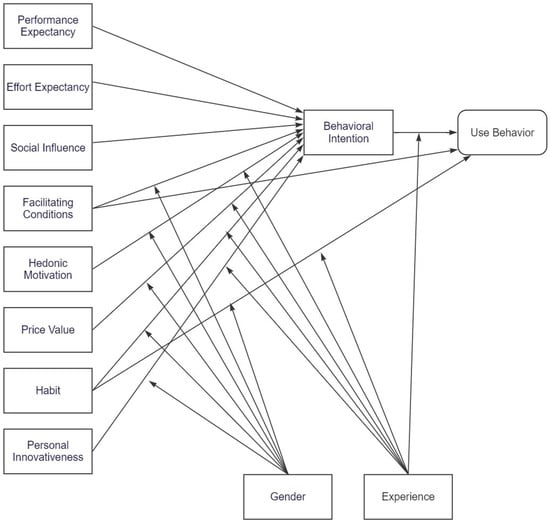
Figure 1
Open AccessArticle
Simulation Modeling and Analysis on the Value-Added Service of the Third-Party E-Commerce Platform Supporting Multi-Value Chain Collaboration
by
Wenbo Li, Yajie Zhang, Bin Dan, Xumei Zhang and Ronghua Sui
J. Theor. Appl. Electron. Commer. Res. 2024, 19(2), 846-862; https://doi.org/10.3390/jtaer19020044 - 08 Apr 2024
Abstract
►▼
Show Figures
Service-oriented third-party e-commerce platforms have emerged as a new trend in the manufacturing industry. This paper aims to investigate the platforms’ value-added service (VAS) and charging strategies with a dynamic evolution analysis. Considering the change in the user numbers and characteristics of the
[...] Read more.
Service-oriented third-party e-commerce platforms have emerged as a new trend in the manufacturing industry. This paper aims to investigate the platforms’ value-added service (VAS) and charging strategies with a dynamic evolution analysis. Considering the change in the user numbers and characteristics of the e-commerce industry, this paper proposes a system dynamics model composed of multi-value chains and a third-party e-commerce platform. The simulation results indicate that the platform should reduce VAS investment and appropriately increase the VAS fee in the early development period. After the number of users stabilizes, the platform should appropriately increase its VAS investment and reduce the VAS fee. When the VAS fee is low, the platform profit first increases and then decreases as the VAS level increases. Differently, the platform profit will first decrease, then increase, and finally decrease as the VAS level improves when the VAS fee is low. This paper further finds that the strong cross-network effect of manufacturers is not always beneficial to the platform.
Full article
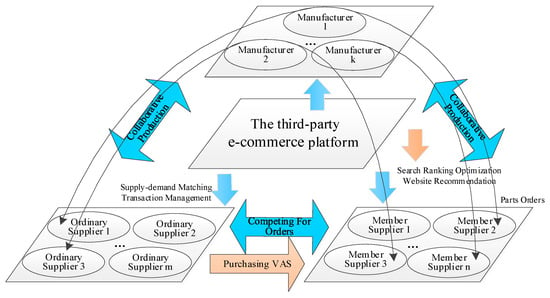
Figure 1
Open AccessArticle
Factors Influencing User Favorability of Government Chatbots on Digital Government Interaction Platforms across Different Scenarios
by
Yuanyuan Guo and Peng Dong
J. Theor. Appl. Electron. Commer. Res. 2024, 19(2), 818-845; https://doi.org/10.3390/jtaer19020043 - 06 Apr 2024
Abstract
►▼
Show Figures
This study investigates the direct and indirect influences of behavioral quality, social support, perceived system, emotional perception, and public expectation on user favorability regarding government chatbots in both government service and policy consultation contexts. The findings reveal that while behavioral quality, social support,
[...] Read more.
This study investigates the direct and indirect influences of behavioral quality, social support, perceived system, emotional perception, and public expectation on user favorability regarding government chatbots in both government service and policy consultation contexts. The findings reveal that while behavioral quality, social support, and perceived system directly affect user favorability in both scenarios, public expectation uniquely impacts user favorability in policy consultation settings, but not in government service scenarios. Furthermore, the analysis indicates that social support, emotional perception, and public expectation all indirectly influence user favorability through their mediating effect on behavioral quality in both contexts. Notably, the significant distinction between the two scenarios is the presence of an indirect impact of perceived system on user favorability within policy consultation scenarios, which is absent in government service scenarios. This study sheds light on the intricate interplay of factors shaping user favorability with government chatbots, and provides valuable insights for improving user experiences and user favorability in different governmental service contexts.
Full article
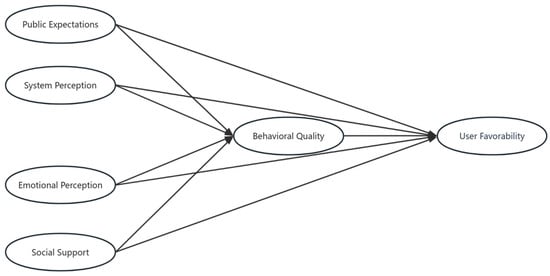
Figure 1
Open AccessArticle
The Use of Digital Channels in Omni-Channel Retail—An Empirical Study
by
Iulia Diana Nagy, Dan-Cristian Dabija, Romana Emilia Cramarenco and Monica Ioana Burcă-Voicu
J. Theor. Appl. Electron. Commer. Res. 2024, 19(2), 797-817; https://doi.org/10.3390/jtaer19020042 - 04 Apr 2024
Abstract
►▼
Show Figures
This article aims to highlight the influencing factors on omni-channel consumer attitudes towards virtual shopping channels, providing the literature with a new conceptual model that studies the use of technology by omni-channel consumers. The research hypotheses were established based on the literature review,
[...] Read more.
This article aims to highlight the influencing factors on omni-channel consumer attitudes towards virtual shopping channels, providing the literature with a new conceptual model that studies the use of technology by omni-channel consumers. The research hypotheses were established based on the literature review, and a conceptual model was defined. Quantitative research was carried out on an emerging market through the survey technique to verify the relations between the investigated concepts. In total, 307 responses from Millennials and Generation Z members were analyzed using structural equations modeling in SmartPLS. The results show that both channel and consumer characteristics, alongside their media contexts, influence the attitude and willingness to access and use retail channels. To keep up with constantly changing consumer needs, companies are advised to continually analyze the target market and implement any necessary measures. The paper expands the studies investigating the behavior of technology users, enhancing the UTAUT2 model-based literature.
Full article
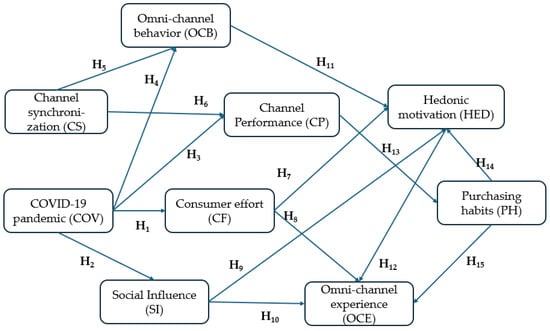
Figure 1
Open AccessArticle
Order Distribution and Routing Optimization for Takeout Delivery under Drone–Rider Joint Delivery Mode
by
Fuqiang Lu, Runxue Jiang, Hualing Bi and Zhiyuan Gao
J. Theor. Appl. Electron. Commer. Res. 2024, 19(2), 774-796; https://doi.org/10.3390/jtaer19020041 - 03 Apr 2024
Abstract
Order distribution and routing optimization of takeout delivery is a challenging research topic in the field of e-commerce. In this paper, we propose a drone–rider joint delivery mode with multi-distribution center collaboration for the problems of limited-service range, unreasonable distribution, high delivery cost,
[...] Read more.
Order distribution and routing optimization of takeout delivery is a challenging research topic in the field of e-commerce. In this paper, we propose a drone–rider joint delivery mode with multi-distribution center collaboration for the problems of limited-service range, unreasonable distribution, high delivery cost, and tight time windows in the takeout delivery process. The model is constructed with the minimum delivery cost and the overall maximum customer satisfaction as the objective function, and a two-stage heuristic algorithm is designed to solve the model. In the first stage, Euclidean distance is used to classify customers into the regions belonging to different distribution centers, and the affinity propagation (AP) clustering algorithm is applied to allocate orders from different distribution centers. The second stage uses an improved tabu search algorithm for route optimization based on specifying the number of rider and drone calls. This paper takes China’s Ele.me and Meituan takeout as the reference object and uses the Solomon data set for research. The experimental results show that compared with the traditional rider delivery mode, the drone–rider joint delivery mode with multiple distribution center collaboration can effectively reduce the number of riders used, lower the delivery cost, and improve the overall customer satisfaction.
Full article
(This article belongs to the Section e-Commerce Analytics)
►▼
Show Figures

Figure 1
Open AccessArticle
Exploring Tourists’ Behavioral Patterns in Bali’s Top-Rated Destinations: Perception and Mobility
by
Dian Puteri Ramadhani, Andry Alamsyah, Mochamad Yudha Febrianta and Lusiana Zulfa Amelia Damayanti
J. Theor. Appl. Electron. Commer. Res. 2024, 19(2), 743-773; https://doi.org/10.3390/jtaer19020040 - 01 Apr 2024
Abstract
The tourism sector plays a crucial role in the global economy, encompassing both physical infrastructure and cultural engagement. Indonesia has a wide range of attractions and has experienced remarkable growth, with Bali as a notable example of this. With the rapid advancements in
[...] Read more.
The tourism sector plays a crucial role in the global economy, encompassing both physical infrastructure and cultural engagement. Indonesia has a wide range of attractions and has experienced remarkable growth, with Bali as a notable example of this. With the rapid advancements in technology, travelers now have the freedom to explore independently, while online travel agencies (OTAs) serve as important resources. Reviews from tourists significantly impact the service quality and perception of destinations, and text mining is a valuable tool for extracting insights from unstructured review data. This research integrates multiclass text classification and a network analysis to uncover tourists’ behavioral patterns through their perceptions and movement. This study innovates beyond conventional sentiment and cognitive image analysis to the tourists’ perceptions of cognitive dimensions and explores the sentiment correlation between different cognitive dimensions. We find that destinations generally receive positive feedback, with 80.36% positive reviews, with natural attractions being the most positive aspect while infrastructure is the least positive aspect. We highlight that qualitative experiences do not always align with quantitative cost-effectiveness evaluations. Through a network analysis, we identify patterns in tourist mobility, highlighting three clusters of attractions that cater to diverse preferences. This research underscores the need for tourism destinations to strategically adapt to tourists’ varied expectations, enhancing their appeal and aligning their services with preferences to elevate destination competitiveness and increase tourist satisfaction.
Full article
(This article belongs to the Topic Online User Behavior in the Context of Big Data)
►▼
Show Figures
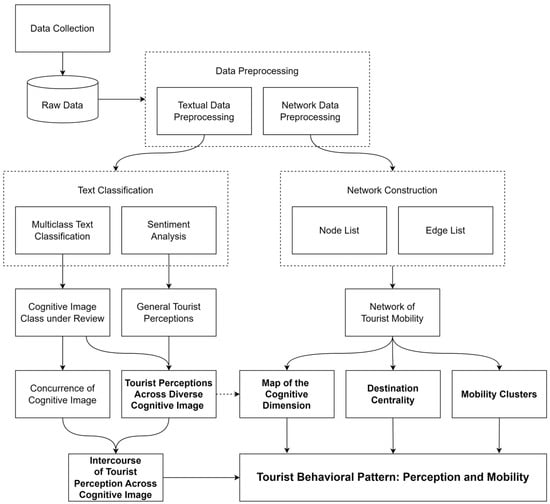
Figure 1
Open AccessArticle
How Social Presence Influences Consumer Well-Being in Live Video Commerce: The Mediating Role of Shopping Enjoyment and the Moderating Role of Familiarity
by
Zhen Huang, Xue Yan and Jia Deng
J. Theor. Appl. Electron. Commer. Res. 2024, 19(2), 725-742; https://doi.org/10.3390/jtaer19020039 - 29 Mar 2024
Abstract
In recent years, with the rapid development of live-streaming commerce, the social dynamics and psychological impact of such online activities merit further discussion. In this study, we investigate the sensory experiences of viewers watching live streaming and examine how these online experiences influence
[...] Read more.
In recent years, with the rapid development of live-streaming commerce, the social dynamics and psychological impact of such online activities merit further discussion. In this study, we investigate the sensory experiences of viewers watching live streaming and examine how these online experiences influence consumer well-being. We developed a conceptual model to understand this mechanism based on the relationship between social presence, shopping enjoyment, familiarity, and consumer well-being. The results of 410 samples indicate that (1) social presence in live-streaming commerce has a significant positive effect on consumer well-being; (2) shopping enjoyment plays a mediating role in the process of social presence predicting consumer well-being; and (3) familiarity plays a moderating role in the second half of the indirect effect of social presence on well-being. This study examines the relationship between social presence and consumer well-being in the context of live-streaming marketing, expanding the research scenario of consumer well-being and clarifying the psychological mechanisms and boundary conditions of the effect of social presence on consumers well-being, which has important implications for online interactive marketing enterprises to enhance social presence and promote consumers long-term well-being.
Full article
(This article belongs to the Topic Consumer Psychology and Business Applications)
►▼
Show Figures
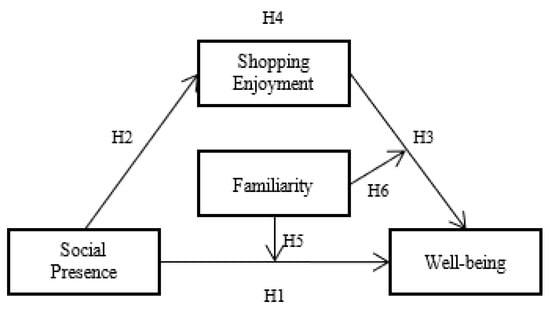
Figure 1
Open AccessArticle
How Social Presence Influences Engagement in Short Video-Embedded Advertisements: The Serial Mediation Effect of Flow Experience and Advertising Avoidance
by
Can Zheng, Shuai Ling, Dongmin Cho and Yonggu Kim
J. Theor. Appl. Electron. Commer. Res. 2024, 19(2), 705-724; https://doi.org/10.3390/jtaer19020038 - 26 Mar 2024
Abstract
Short video platforms have problems with increased competition and low advertising conversion rates. Although social presence is closely related to consumer engagement, research regarding the impact of social presence on consumer engagement in short video-embedded advertisements is sparse. We developed a theoretical model,
[...] Read more.
Short video platforms have problems with increased competition and low advertising conversion rates. Although social presence is closely related to consumer engagement, research regarding the impact of social presence on consumer engagement in short video-embedded advertisements is sparse. We developed a theoretical model, namely a social presence–flow experience–advertising avoidance–advertising engagement model, and explored the mechanism underlying advertising engagement from a psychological and behavioral perspective. The analysis of 563 short video users revealed that the model exhibited excellent explanatory power for advertising engagement (R2 = 41.3%). Social presence can increase consumers’ advertising engagement by enhancing flow experience and reducing advertising avoidance. Meanwhile, the flow experience, by diminishing advertising avoidance, generates a serial mediation effect between social presence and advertising engagement. This study emphasizes social presence’s applicability and influence mechanism in short video-embedded advertisements, a unidirectional information delivery. It provides new theoretical perspectives and practical advice for relevant practitioners.
Full article
(This article belongs to the Section Digital Marketing and the Connected Consumer)
►▼
Show Figures

Figure 1
Open AccessArticle
The Effect of AI Agent Gender on Trust and Grounding
by
Joo-Eon Jeon
J. Theor. Appl. Electron. Commer. Res. 2024, 19(1), 692-704; https://doi.org/10.3390/jtaer19010037 - 21 Mar 2024
Abstract
Artificial intelligence (AI) agents are widely used in the retail and distribution industry. The primary objective was to investigate whether the gender of AI agents influences trust and grounding. This paper examined the influence of AI agent gender and brand concepts on trust
[...] Read more.
Artificial intelligence (AI) agents are widely used in the retail and distribution industry. The primary objective was to investigate whether the gender of AI agents influences trust and grounding. This paper examined the influence of AI agent gender and brand concepts on trust and grounding within virtual brand spaces. For this purpose, it used two independent variables: brand concept (functional vs. experiential) and AI agent gender (male vs. female). The dependent variables included AI agent trust and grounding. The study revealed that in virtual brand spaces centered around a functional concept, male AI agents generated higher levels of trust than female AI agents, whereas, when focused on an experiential concept, female AI agents induced higher levels of grounding than male AI agents. Furthermore, the findings indicate that the association between customers’ identification with AI agents and recommendations for actual brand purchases is mediated by trust and grounding. These findings support the idea that users who strongly identify with AI agents are more inclined to recommend brand products. By presenting alternatives that foster the establishment and sustenance of a meaningful, sustainable relationship between humans and AI, this study contributes to research on human–computer interactions.
Full article
(This article belongs to the Collection Customer Relationships in Electronic Commerce)
►▼
Show Figures
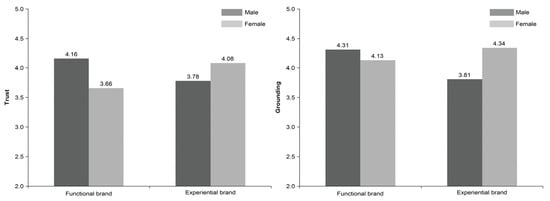
Figure 1
Open AccessArticle
Social Media Managers’ Performance: The Impact of the Work Environment
by
Zaira Camoiras-Rodríguez and Concepción Varela-Neira
J. Theor. Appl. Electron. Commer. Res. 2024, 19(1), 671-691; https://doi.org/10.3390/jtaer19010036 - 18 Mar 2024
Abstract
►▼
Show Figures
The continuous growth of social media is causing significant modifications in the business strategies developed by organizations. Using a structural equation modeling approach, this research analyzes how the work environment affects the social media managers thriving at work and task performance. The proposed
[...] Read more.
The continuous growth of social media is causing significant modifications in the business strategies developed by organizations. Using a structural equation modeling approach, this research analyzes how the work environment affects the social media managers thriving at work and task performance. The proposed model is tested using a sample of 190 social media managers and 190 supervisors from 190 companies in the tourism sector. The results highlight the importance of proper design and implementation of social media marketing planning and top management support to enhance both thriving at work and the performance of social media managers. This research contributes to the literature on social media by examining how and when the work environment influences the attitudes and performance of social media managers, whose role is crucial in organizational performance. Simultaneously, it expands the literature on thriving, as knowledge about the impact of contextual factors on thriving is still limited. The results also demonstrate that managers can compensate for the lack of certain contextual or personal resources with other resources, providing insights into when the work environment is more beneficial in shaping positive attitudes and behaviors in employees.
Full article

Figure 1
Open AccessArticle
Unlocking the Potential of Artificial Intelligence in Fashion Design and E-Commerce Applications: The Case of Midjourney
by
Yanbo Zhang and Chuanlan Liu
J. Theor. Appl. Electron. Commer. Res. 2024, 19(1), 654-670; https://doi.org/10.3390/jtaer19010035 - 18 Mar 2024
Abstract
The fashion industry has shown increasing interest in applying artificial intelligence (AI), yet there is a significant gap in exploring the potential of emerging diffusion-modeling-based AI image-generation systems for fashion design and commerce. Therefore, this study aims to assess the effectiveness of Midjourney,
[...] Read more.
The fashion industry has shown increasing interest in applying artificial intelligence (AI), yet there is a significant gap in exploring the potential of emerging diffusion-modeling-based AI image-generation systems for fashion design and commerce. Therefore, this study aims to assess the effectiveness of Midjourney, one such AI system, in both fashion design and related commerce applications. We employed the action research approach with the Functional, Expressive, and Aesthetic (FEA) Consumer Needs Model as the theoretical framework. Our research comprised three stages: refining an initial idea into well-defined textual design concepts, facilitating concept development, and validating the preceding observations and reflections by creating a new line of hemp-based products that were evaluated by targeted consumers through an online survey. Findings reveal that this AI tool can assist fashion designers in creating both visually expressive attire and ready-to-wear products, meeting defined design criteria and consumer needs. Midjourney shows promise in streamlining the fashion design process by enhancing ideation and optimizing design details. Potential e-commercial applications of such AI systems were proposed, benefiting physical and digital fashion businesses. It is noted that, to date, the major limitations of using Midjourney encompass its restriction to only facilitating early fashion design stages and necessitating substantial involvement from designers.
Full article
(This article belongs to the Collection Exploring the Future of Creative Economy: Transforming Creative Industries through Innovation, Technology and Enhanced Consumer Engagement)
►▼
Show Figures
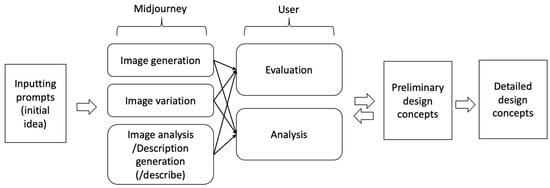
Figure 1
Open AccessArticle
Mobile Payment Innovation Ecosystem and Mechanism: A Case Study of Taiwan’s Servicescapes
by
Wai-Kit Ng, Shi Chen, Wei-Hung Chen, Chun-Liang Chen and Jhih-Ling Jiang
J. Theor. Appl. Electron. Commer. Res. 2024, 19(1), 633-653; https://doi.org/10.3390/jtaer19010034 - 15 Mar 2024
Abstract
►▼
Show Figures
This paper examines how businesses in Taiwan’s servicescapes are adapting to the growing trend of mobile payments and innovation ecosystems. Through the analysis of four case studies, we uncover the strategies these firms employ to address the challenges posed by changing consumer payment
[...] Read more.
This paper examines how businesses in Taiwan’s servicescapes are adapting to the growing trend of mobile payments and innovation ecosystems. Through the analysis of four case studies, we uncover the strategies these firms employ to address the challenges posed by changing consumer payment habits. Our research reveals that these companies are establishing efficient mechanisms within their ecosystems, supported by well-structured organizational frameworks. By leveraging innovation ecosystems, they are reshaping financial services and promoting collaborative growth among participants through technology, platforms, resource sharing, and knowledge exchange. This collaborative approach is driving significant changes in the sector, helping these businesses navigate through various challenges while fostering innovation and growth. Additionally, the scarcity of comprehensive observations of the digital payment ecosystem highlights the necessity for further exploration of actor interactions, regulatory mechanisms, and ecosystem management strategies. Such research efforts are crucial for enhancing our understanding of the evolving landscape of digital payments and innovation ecosystems, facilitating informed decision-making and promoting sustainable development in this dynamic industry.
Full article
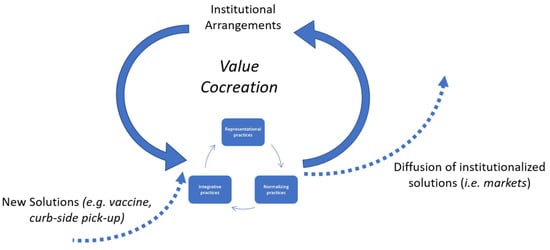
Figure 1
Open AccessArticle
Influence of Electronic Word-Of-Mouth on Restaurant Choice Decisions: Does It Depend on Gender in the Millennial Generation?
by
Giovanny Haro-Sosa, Beatriz Moliner-Velázquez, Irene Gil-Saura and María Fuentes-Blasco
J. Theor. Appl. Electron. Commer. Res. 2024, 19(1), 615-632; https://doi.org/10.3390/jtaer19010033 - 14 Mar 2024
Abstract
►▼
Show Figures
Given the exponential growth of eWOM, especially among the millennial generation, an analysis of the consultation behaviour of online opinions is essential to better understanding the decision-making process. The aim of this proposal is to analyse how the motivations towards eWOM consultation contribute
[...] Read more.
Given the exponential growth of eWOM, especially among the millennial generation, an analysis of the consultation behaviour of online opinions is essential to better understanding the decision-making process. The aim of this proposal is to analyse how the motivations towards eWOM consultation contribute to the final adoption of eWOM, especially in the restaurant context, exploring the relationship chain “motivations to consult eWOM—intention to consult eWOM—adoption to consult eWOM”. Moreover, studying the moderating effect of gender in this chain is argued. Based on a sample of 341 millennials with experience in reading online reviews and visiting restaurants, a causal model was estimated through PLS estimation in the geographic area of Ecuador. The results confirm that millennials’ motivations influence directly their intention to consult eWOM and indirectly on eWOM adoption. In addition, gender does not show a significant effect on the chain of effects. Given that virtual platforms have the potential to influence men and women equally, the communication efforts of restaurants focused on this target audience and carried out on social media must focus on aspects other than gender.
Full article

Figure 1
Open AccessPerspective
Fog Computing-Based Smart Consumer Recommender Systems
by
Jacob Hornik, Chezy Ofir, Matti Rachamim and Sergei Graguer
J. Theor. Appl. Electron. Commer. Res. 2024, 19(1), 597-614; https://doi.org/10.3390/jtaer19010032 - 11 Mar 2024
Abstract
►▼
Show Figures
The latest effort in delivering computing resources as a service to managers and consumers represents a shift away from computing as a product that is purchased, to computing as a service that is delivered to users over the internet from large-scale data centers.
[...] Read more.
The latest effort in delivering computing resources as a service to managers and consumers represents a shift away from computing as a product that is purchased, to computing as a service that is delivered to users over the internet from large-scale data centers. However, with the advent of the cloud-based IoT and artificial intelligence (AI), which are advancing customer experience automations in many application areas, such as recommender systems (RS), a need has arisen for various modifications to support the IoT devices that are at the center of the automation world, including recent language models like ChatGPT and Bard and technologies like nanotechnology. This paper introduces the marketing community to a recent computing development: IoT-driven fog computing (FC). Although numerous research studies have been published on FC “smart” applications, none hitherto have been conducted on fog-based smart marketing domains such as recommender systems. FC is considered a novel computational system, which can mitigate latency and improve bandwidth utilization for autonomous consumer behavior applications requiring real-time data-driven decision making. This paper provides a conceptual framework for studying the effects of fog computing on consumer behavior, with the goal of stimulating future research by using, as an example, the intersection of FC and RS. Indeed, our conceptualization of the “fog-based recommender systems” opens many novel and challenging avenues for academic research, some of which are highlighted in the later part of this paper.
Full article

Figure 1
Open AccessArticle
How Personality Traits Affect Customer Empathy Expression of Social Media Ads and Purchasing Intention: A Psychological Perspective
by
Serhan Demirci, Chia-Ju Ling, Dai-Rong Lee and Chien-Wen Chen
J. Theor. Appl. Electron. Commer. Res. 2024, 19(1), 581-596; https://doi.org/10.3390/jtaer19010031 - 07 Mar 2024
Abstract
►▼
Show Figures
Consumers’ personality traits significantly influence their perceptions regarding social media advertising. While prior research on consumers’ purchasing intentions in social networking sites advertising has mainly focused on advertising valence antecedents, it is crucial to recognize that consumers’ susceptibility to advertising persuasion, particularly in
[...] Read more.
Consumers’ personality traits significantly influence their perceptions regarding social media advertising. While prior research on consumers’ purchasing intentions in social networking sites advertising has mainly focused on advertising valence antecedents, it is crucial to recognize that consumers’ susceptibility to advertising persuasion, particularly in terms of empathic expression, varies based on a key criterion: whether consumers are driven to attain a specific desired state or are more inclined to avoid an undesirable state. Regulatory Focus Theory (RFT) posits that individuals operate under distinct motivational mechanisms that govern their determination to achieve desired goals, influencing how they process and evaluate advertising messages. In light of RFT, we conducted an online survey with 524 valid responses, utilizing partial least squares (PLS) for research model analysis. The findings revealed that promotion-focused individuals have positively influenced perceptions of social media ad effectiveness (informativeness, ad creativity, perceived relevance, and emotional appeal). In contrast, prevention-focused individuals negatively perceived social media ad effectiveness. Furthermore, this study highlighted that perceived relevance and emotional appeal have a more significant impact on attitudes toward expressing empathy than informativeness and ad creativity.
Full article
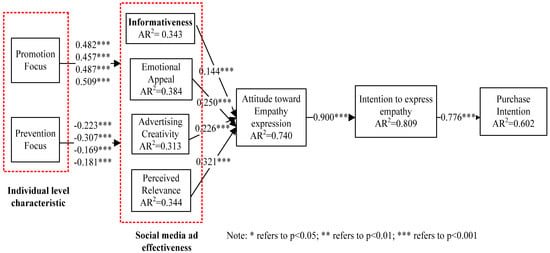
Figure 1

Journal Menu
► ▼ Journal MenuJournal Browser
► ▼ Journal Browser-
arrow_forward_ios
Forthcoming issue
arrow_forward_ios Current issue - Volumes not published by MDPI
Highly Accessed Articles
Latest Books
E-Mail Alert
News
Topics
Topic in
Administrative Sciences, Behavioral Sciences, JTAER
Consumer Psychology and Business Applications
Topic Editors: Chenglu Wang, Henry F. L. Chung, Jin Sun, Yongge Niu, Liying ZhouDeadline: 31 October 2024

Conferences
Special Issues
Topical Collections
Topical Collection in
JTAER
The New Era of Digital Marketing
Collection Editors: Shib Sankar Sana, Sweety Sadhukhan
Topical Collection in
JTAER
Enhancing Consumer Experience through Mobile Commerce: Challenges and Opportunities
Collection Editors: Rebeka-Anna Pop, Dan-Cristian Dabija, Cristinel Vasiliu
Topical Collection in
JTAER
Customer Relationships in Electronic Commerce
Collection Editor: Yung-Shen Yen
Topical Collection in
JTAER
The Connected Consumer
Collection Editors: Inma Rodríguez-Ardura, Gisela Ammetller


